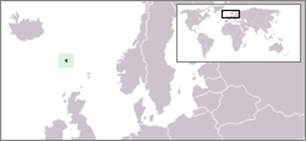P=have O=don’t have it
Faroe Islands – A group
islands between the Norwegian Sea and the North Atlantic Ocean, about one-half
of the way from Iceland to Norway.
The Faroe Islands are a constituent country of the
See: FACTS ABOUT THE FAROE ISLANDS
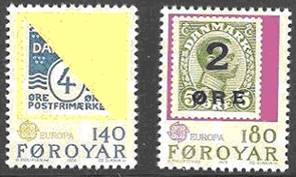
Scott: #43-4P
Issued: 7.5.1979
EUROPA-CEPT 1979
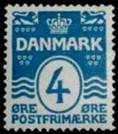 Inside
#43:
Inside
#43:
Bisect: stamp cut in half which has been used to pay the
postage at half the face value of the original stamp; the bisect should becollected on the original cover with the postmark or
cancellation covering the cut. http://www.askphil.org/b25b.htm
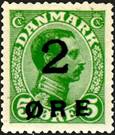 Inside
#44:
Inside
#44:
An interesting period in
the Faroese history of philately is the time shortly after the First World War,
when the Faroese Post Office was forced to use so called provisional-stamps. On
8 December 1918 the Post Office in Tórshavn
received a message from Copenhagen about the following increase of postal
rates:
·
Inland letters on the Faroes up
to 250 gran (15 g) from 5 øre to 7 øre
·
Postcards to Denmark up to 250 gran
(15 g) from 4 øre to 7 øre
The increase in postal
rates came into force on 1 January 1919.
Due to unreliable
shipping connections, the supply of new 7-øre postage stamps failed to
reach the Post Office in Tórshavn before 1st
January 1919. When it became apparent that the increase in the postal rates
would bring about a heavy demand for stamps amounting to 7 øre,
and that the Faroese Post Offices´ stock of supplementary stamps, 1-, 2-, 3-
and 4-øre, would not be sufficient to meet demand, special provisions
had to be made. Thus the Post Office in Tórshavn
received authorization to bisect the ordinary 4-øre stamps and use the
individual halves as 2-øre stamps.
When the stock of
4-øre stamps began to run low, the Post Office was given authorization
to overprint the required number of 5-øre stamps and use them as
2-øre stamps. For this purpose a hand stamp was made out of a wooden
block bearing the letters "2 ØRE". Part of a chair leg was
used as handle, and therefor the stamp was called
"The chair leg stamp".
http://en.wikipedia.org/wiki/Postverk_F%C3%B8roya
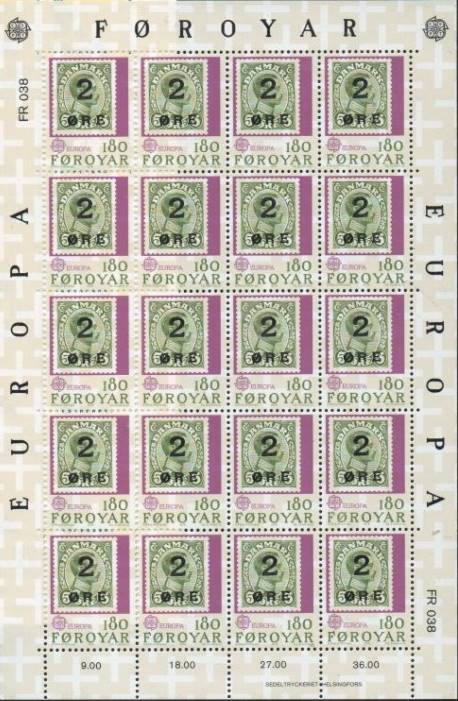
Scott: #44P
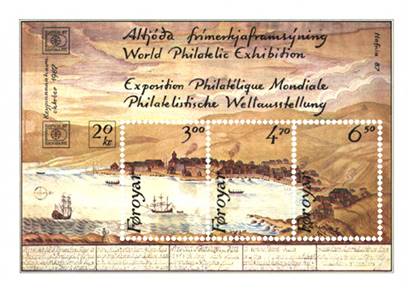
Scott: #148O
Issued: 29.8.1986
HAFNIA '87
Inside #148: Emblem

Scott: #168O
Issued: 16.10.1987
HAFNIA '87
Inside #168: Pseudo Stamp

Scott: #???-?O
Issued: 01.10.2014
40th Anniversary of Faroe Island Stamps
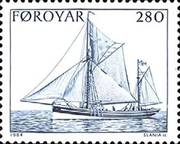 Inside #???: Faroe Islands #112P
Inside #???: Faroe Islands #112P
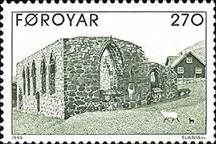 Inside #???: Faroe Islands #182O
Inside #???: Faroe Islands #182O
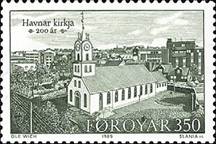 Inside #???: Faroe Islands #186P
Inside #???: Faroe Islands #186P
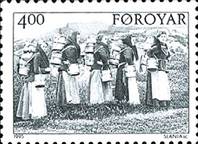 Inside #???: Faroe Islands #290O
Inside #???: Faroe Islands #290O
Thanks to Lou Guadagno
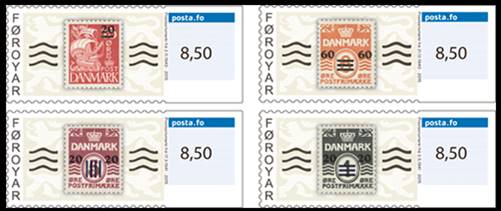
Scott: #???-?O
Issued: 01.10.2015
Provisional Stamps 1940-41
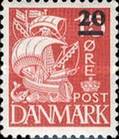 Inside #???: Faroe Islands #4O
Inside #???: Faroe Islands #4O
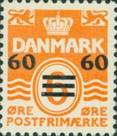 Inside #???: Faroe Islands #6O
Inside #???: Faroe Islands #6O
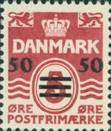 Inside #???: Faroe Islands #5O
Inside #???: Faroe Islands #5O
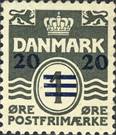 Inside #???: Faroe Islands #2O
Inside #???: Faroe Islands #2O
75 years since the
Provisional Stamps during WW2 were taken into use
The two World Wars caused
many disruptions and disturbances in the Faroe Islands. The Faroes was occupied
by British forces and became totally isolated from the Danish Kingdom, the only
outside connections being via UK and Iceland. Soon there was scarcity of daily
necessities and already in 1939 ration cards were taken into use. Provisional
bank notes were introduced as well.
It was also an irony of
history that both in 1919 and 1940 the Post Office started having fears of
stamp shortage. Postmaster General Johan Danielsen
knew well that the situation could arise as it had done in 1919.
It became quite clear to
the Postmaster that the stock of current values was hardly sufficient while
there was an abundance of other values.
It soon became evident
that the prerequisites for getting more stamps to the Faroes were
unsatisfactory even though the war started in September 1939 and Denmark was
not occupied until April 9th 1940. There were regular postal connections, but
during the autumn of 1939 British Authorities ordered the shipping companies
DFDS and Bergenske, carrying mail between Denmark and
Faroes, to call at Kirkwall en route in order for the
mail to be examined, which of course meant censorship. As a consequence in
February 1940 the shipping companies declared that they no longer would accept
mail on these routes.
Partly due to these
difficulties of navigation and bad ice conditions in Skagerrak and Kattegat,
the Tórshavn Post Office did not obtain the
necessary stamps prior to the occupation of Denmark on the April 9th 1940. On
April 13th that year the first 250 British soldiers were sent ashore in the
Faroes. “Islandsk Falk”, arriving in Tórshavn on the 23rd February 1940, was the last
vessel to maintain normal postal connections between the Faroes and Denmark
until the end of the war.
It did not make life
easier for Postmaster Danielsen that Danish High
Commissioner Hilbert, perhaps wanting to underscore his position as “The
Governor”, ordered that the new postal tariffs in Denmark be adopted in the
Faroes as of 10th July 1940 - this in spite of doubts whether it was at all
possibly to supply the Faroes with the new values which meant an increase in
the price of an ordinary letter from 15 øre to
20 øre!
Already on April 27th
1940 Postmaster Danielsen had written to the UPU
office in Bern requesting that new Danish stamps be sent to Faroes via neutral
countries. However, no one knew how this would be possible.
One of the first
solutions Mr Danielsen had
in mind was a so-called FRANCO PAID hand cancellation with the values of 5 øre, 10 øre and 20 øre. Four sets were produced to be used in Tórshavn, Klaksvík,
Tvøroyri and Vágur.
However, Mr Danielsen had a change of
mind, not being satisfied with this un- traditional solution. He preferred the
well-known solution of 1919 where the post offices whenever necessary made use
of over-printed stamps. The FRANCO hand cancellations were temporarily discarded.
The introduction of
over-printed stamps
The printer H.N.J
Bookstore played an important part when the decision of over-printing the first
stamps was taken in the autumn of 1940. Postmaster Danielsen
had been taken ill and therefore the acting Postmaster, chief controller
Laurits D. Hansen, conducted the operation.
Two sheets of postage
stamps, the red 15 øre “Karavel”
were used as sample prints with the value 20 printed over the 15. These sample
prints, however, were unsuccessful because the overprinting was hardly visible
to the naked eye. Consequently a bar was placed under the value “20” when the
stock of 1399 sheets was printed. These stamps were sold for the first time on
November 2nd 1940.
Even if some parcels with
stamps from Denmark arrived in Faroes via neutral countries after this first
overprinting, the list of over-printed stamps during World War II grew longer
due to various values being depleted.
The overprinted stamps
used in 1940-41 were as follows:
20/15 øre
red (AFA203a) 2.11.1940 …..…139.900 exemplars
50/5 øre
wine red (AFA246) 6.121940……...25.000 -
60/6 øre
orange yellow (254) 21.12.1940…….17.500 -
20/1 øre
green black (196a) 2.05.1941……..42.500 -
20/5 øre
wine red (246) 17.03.1941…….70.000 -
In the summer of 1941 the
second edition was over-printed:
20/1 øre
green black (196) 3.06.1941………4.000 examplars
60/6 øre
orange yellow (254) 11.06.1941……5.000 -
50/5 øre
wine red (246) 23.06.1941…………2.500 –
There is a difference
between the first and second printing; the space between the zeroes in the
over-printed stamps is 13 mm. Since the HNJ printers were a traditional book
printer many other variations are to be found in all these sheets.
FRANCO PAID taken into
use
Early in 1941 both Mr Danielsen and Mr Hilbert realised that the
situation was far from satisfactory. In spite of the new overprints other
arrangements had to be made. It was even suggested that British stamps be used
in the Faroes but instead Postmaster Danielsen and
Governor Hilbert agreed to use the FRANCO PAID hand cancellations mentioned
earlier! Later the figure “5” was removed so the postal staff could instead
write the actual value of the mail.
In a report after the war
Postmaster Danielsen wrote that these cancellations
were taken into use due to “the gravest need”.
6 øre
stamps sold as 5 øre
A consignment of stamps
from Denmark arrived in early June 1941. It came in handy but the lowest value
was 8 øre and at the time the Post Office was
running out of the 5 øre value. As a
consequence something happened in the Torshavn Post Office that may well be
termed a “world sensation”.
Postmaster Danielsen ordered that in the period May 26th - September
8th 1941 no less than 180 sheets of 6 øre
stamps be sold for 5 øre each stamp!
Besides a franking
machine was ordered from Britain. It did not arrive until 1943 and was not used
to any great extent.
Shipments of stamps had
now improved and after 1943 there was no need for any special measures to cover
the demand for stamps in the Faroes.
It can be added to this
story that on the April 5th 1952 Aage Tholl, the well-known Danish stamp collector, who is a
devoted admirer of Faroese postal history, sent a request to the Danish post
authorities asking whether overprints from 1940-41 still were valid to use. Mr Tholl received an affirmative
reply! However, in a letter to the Tórshavn
Post Office dated July 2nd 1953 the Postal Administration invalidated the use
of overprints which in reality has been a temporary arrangement in the Faroe
Islands during the Second World War.
Already then life in the
Faroes had returned to normal even if ration cards and shortage of goods
persisted until the end of 1952.
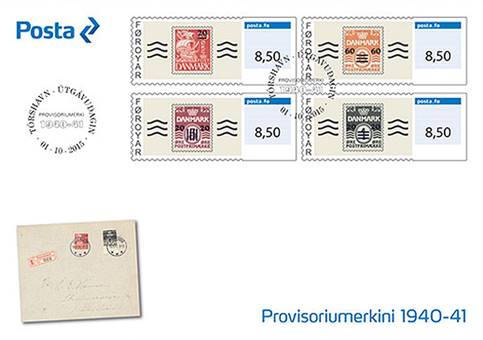
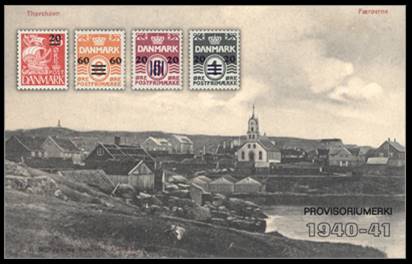
Postcard - provisional
stamps
Posta has issued a
postcard in connection with the 75th jubilee of the provisonal
stamps on 2 November 2015. The postcard can also be purchased cancelled with a ordinary day cancellation from 2 November 2015 and
franked with one of the franking labels from 2015.
The postcard is a reprint
of an old postcard. It depicts Tórshavn around
year 1900. Four of the provisional stamps are also shown on the front.
The original postcard was
printed and issued by H.N.J. Bookstore in 1906.
Thanks to Lou Guadagno

Scott: #????O
Issued: ??.??.2019
100 Anniversary to 1919 Essays
 Inside
#????:
Inside
#????:
An interesting period in
the Faroese history of philately is the time shortly after the First World War,
when the Faroese Post Office was forced to use so called provisional-stamps. On
8 December 1918 the Post Office in Tórshavn
received a message from Copenhagen about the following increase of postal
rates:
·
Inland letters on the Faroes up
to 250 gran (15 g) from 5 øre to 7 øre
·
Postcards to Denmark up to 250 gran
(15 g) from 4 øre to 7 øre
The increase in postal
rates came into force on 1 January 1919.
Due to unreliable
shipping connections, the supply of new 7-øre postage stamps failed to
reach the Post Office in Tórshavn before 1st
January 1919. When it became apparent that the increase in the postal rates
would bring about a heavy demand for stamps amounting to 7 øre,
and that the Faroese Post Offices´ stock of supplementary stamps, 1-, 2-, 3- and
4-øre, would not be sufficient to meet demand, special provisions had to
be made. Thus the Post Office in Tórshavn
received authorization to bisect the ordinary 4-øre stamps and use the
individual halves as 2-øre stamps.
When the stock of
4-øre stamps began to run low, the Post Office was given authorization
to overprint the required number of 5-øre stamps and use them as
2-øre stamps. For this purpose a hand stamp was made out of a wooden
block bearing the letters "2 ØRE". Part of a chair leg was
used as handle, and therefor the stamp was called
"The chair leg stamp".
http://en.wikipedia.org/wiki/Postverk_F%C3%B8roya
Thanks to Richelmi Plinio
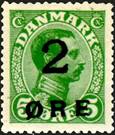
Scott: #???O
Issued: 24.02.2025
50th Anniversary of Faroe Island Stamps
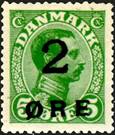 Inside #???: Faroe
Islands #42
Inside #???: Faroe
Islands #42
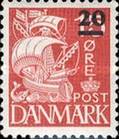
FDC
Lou wrote: On February
24, 2025, the Faroe islands will issue a 50Kr valued s/s to commemorate 50
years of Faroes Stamps; depicted is a simplified lithographed attempt to copy,
in monotone, only details of Slania's engraved Ram's
Head on Faroe Islands Sc #42 issued in 1979. I have
described it as a Design Component in my personal lists. The actual stamp is
one of only a few Slania engravings to be colored,
hiding much of his wonderful detail.
Thanks to Lou Guadagno
Best website
related:

![]()
Wish List

Faroe Islands #1
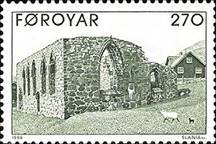
Faroe Islands #2
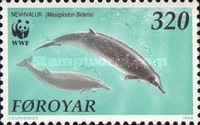
Faroe Islands #4
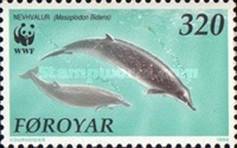
Faroe Islands #5
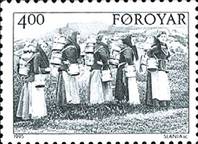
Faroe Islands #6
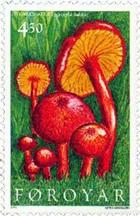
Faroe Islands #148
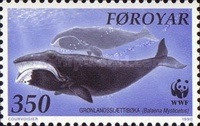
Faroe Islands #168

Faroe Islands #182
![[North Atlantic Whales, type GJ]](Faroe%20Islands_image062.jpg)
Faroe Islands #208 for Djibuti
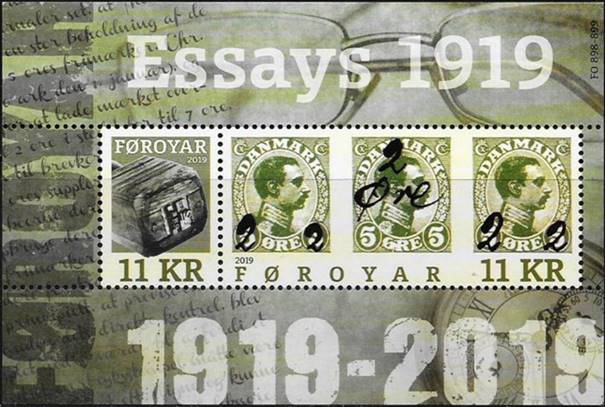
Faroe Islands #290
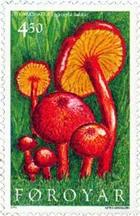
Faroe Is. #315 for Guinea
![[North Atlantic Whales, Scrivi GK]](Faroe%20Islands_image065.jpg)
Faroe Is. 1990 for Sierra Leone
![[North Atlantic Whales, type GL]](Faroe%20Islands_image066.jpg)
Faroe Is. 1990 for Sierra Leone
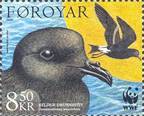
Faroe Is. #458 for Djibouti

Faroe Islands #???-? (2014)

Scott: #???-? (2015)
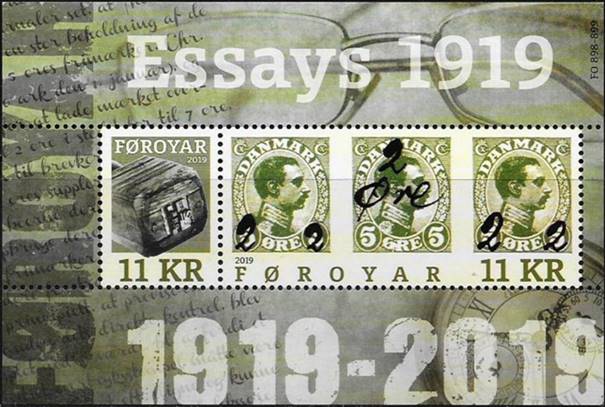
Scott: #???? (2019)

Scott: #????
(2025)

